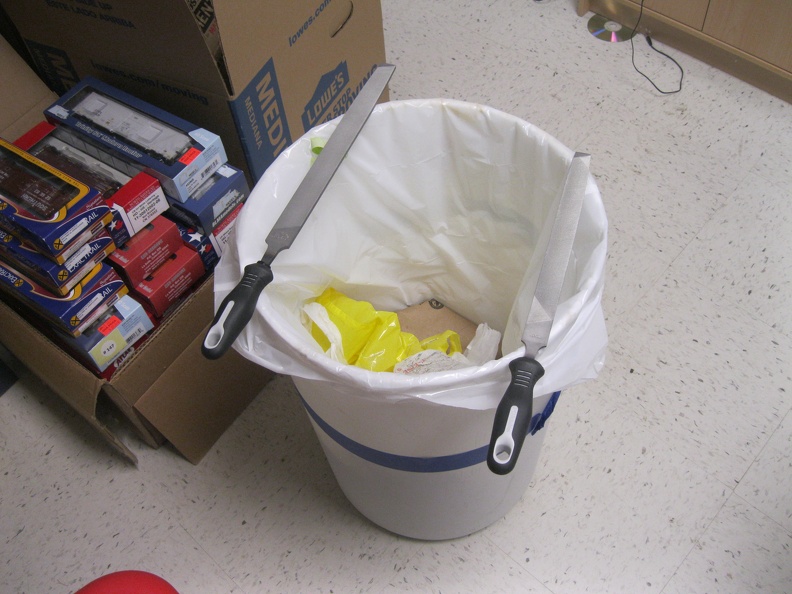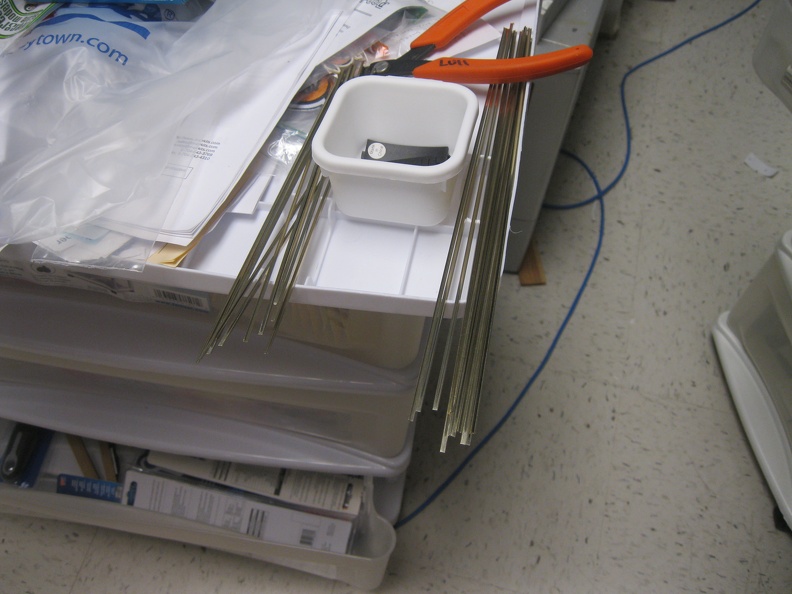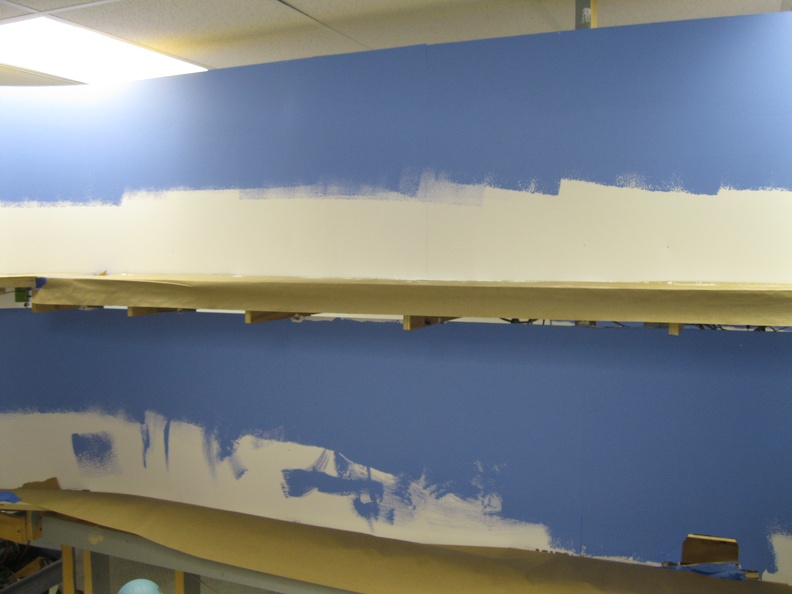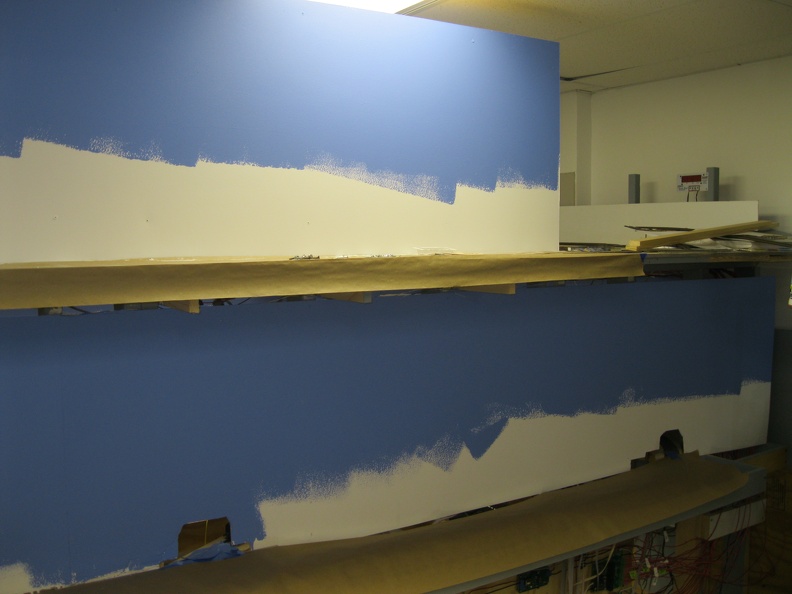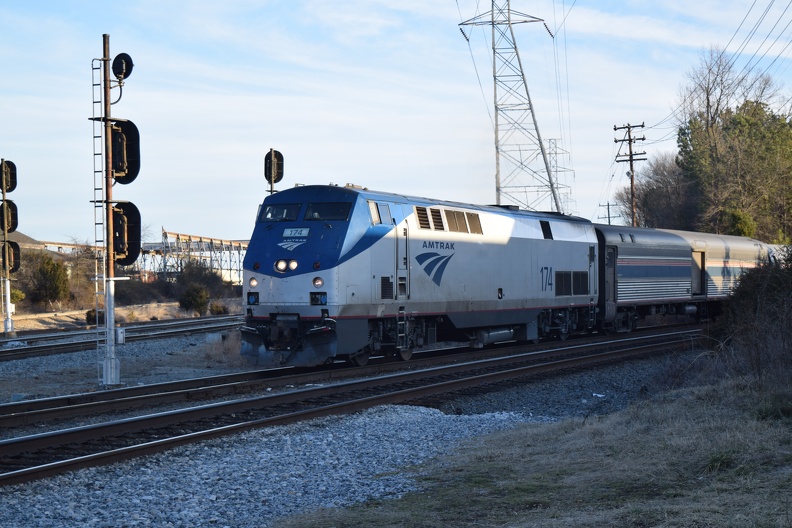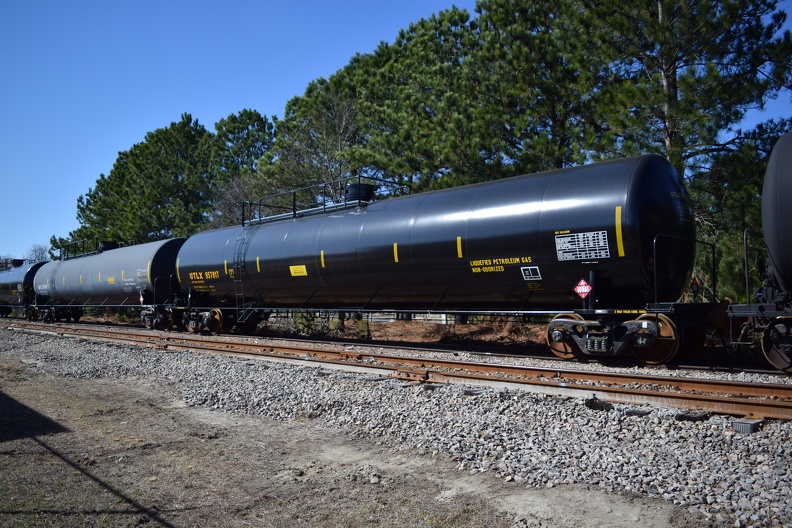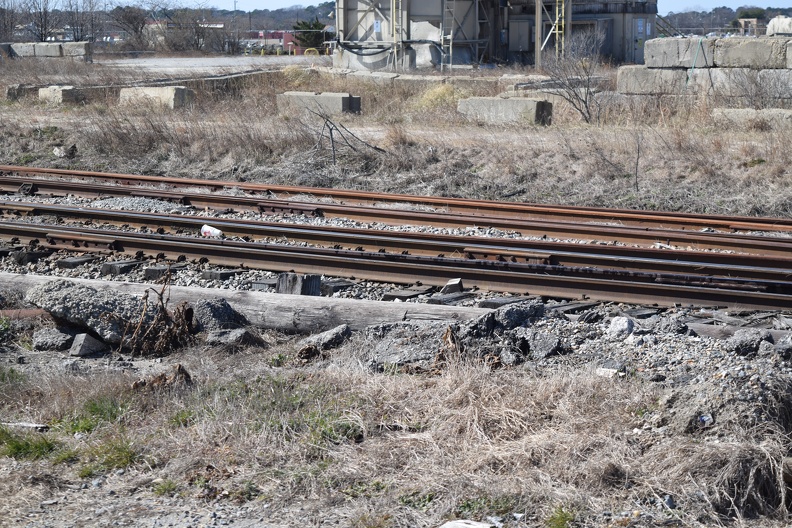Posting prototype pictures to the gallery today. These as smallish JPGs that I've run through a watermark batch. If you'd like to purchase rights to a photo for research or modeling, please contact me for large (6000x4000 JPGs and Nikon RAW) files.
Rick
Saturday, August 8, 2015
Friday, July 17, 2015
A teaser
Thursday, July 16, 2015
June 2015 Op Session Recap
An operating session was held June 13 on the Richmond Terminal.
A full crew was present to put the railroad through its paces.
The session was the first with a larger Amtrak schedule, with trains better following the prototype (Amfleets used for everything except the Auto-Train; sleeper and diner on Silver service).
A couple of issues were found during the running of the session so changes will be in order for the next session, which should hopefully be August, but might have to get bumped to October.
I am going to document the waybills in a how-to as the crews continue to be confused by the process. (In their defense, my CC/WB system differs from everybody else in town and my operating being few and far between doesn't help)
Pictures follow:
A full crew was present to put the railroad through its paces.
The session was the first with a larger Amtrak schedule, with trains better following the prototype (Amfleets used for everything except the Auto-Train; sleeper and diner on Silver service).
A couple of issues were found during the running of the session so changes will be in order for the next session, which should hopefully be August, but might have to get bumped to October.
I am going to document the waybills in a how-to as the crews continue to be confused by the process. (In their defense, my CC/WB system differs from everybody else in town and my operating being few and far between doesn't help)
Pictures follow:
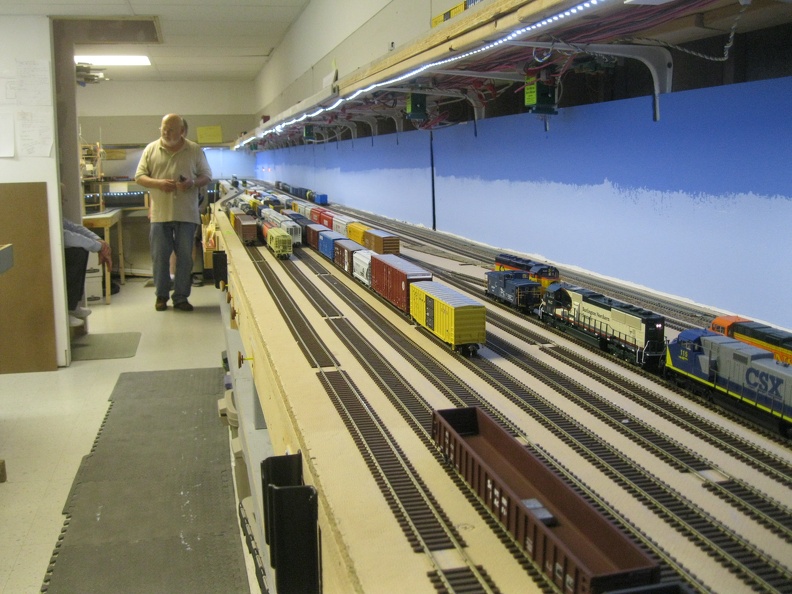 |
| Doug B working Acca; yard looks pretty empty at this stage in the session. |
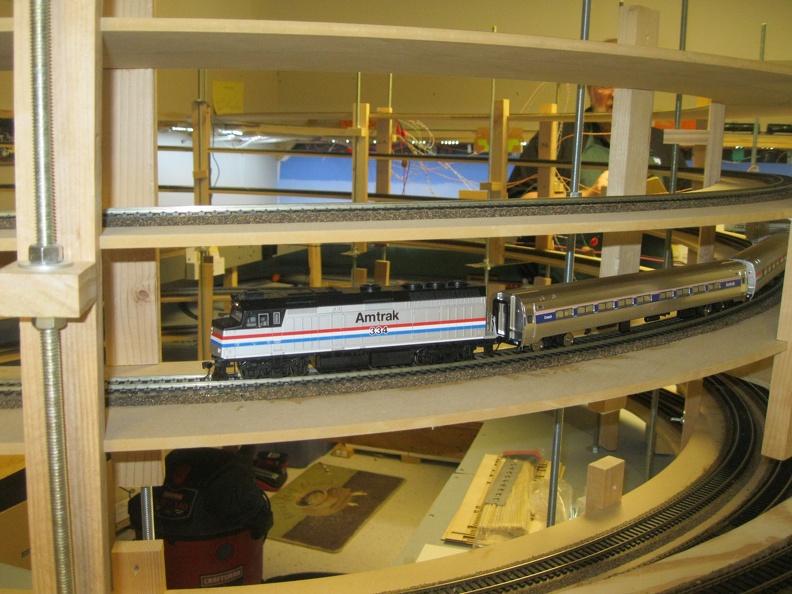 |
| The Carolinian is southbound after its station stop at Staples Mill. |
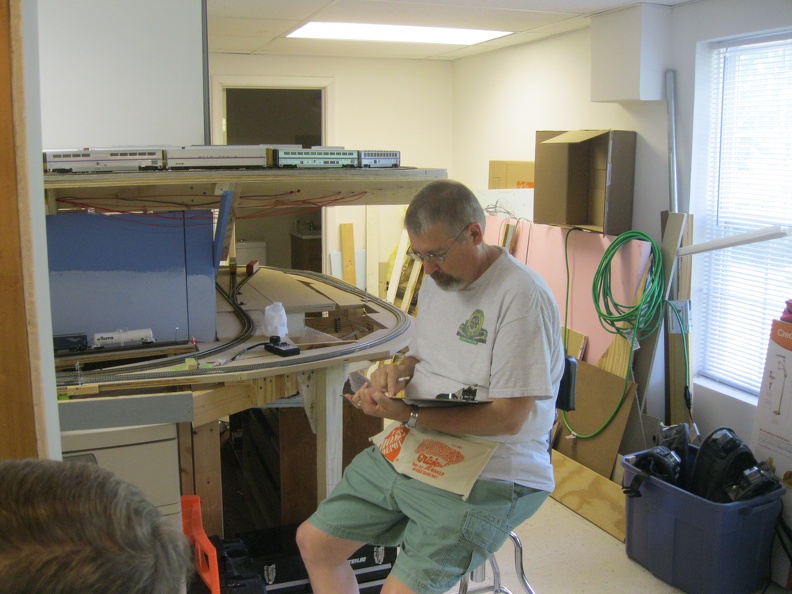 |
| Mike G making sure he is set for the next staging arrival and departure. |
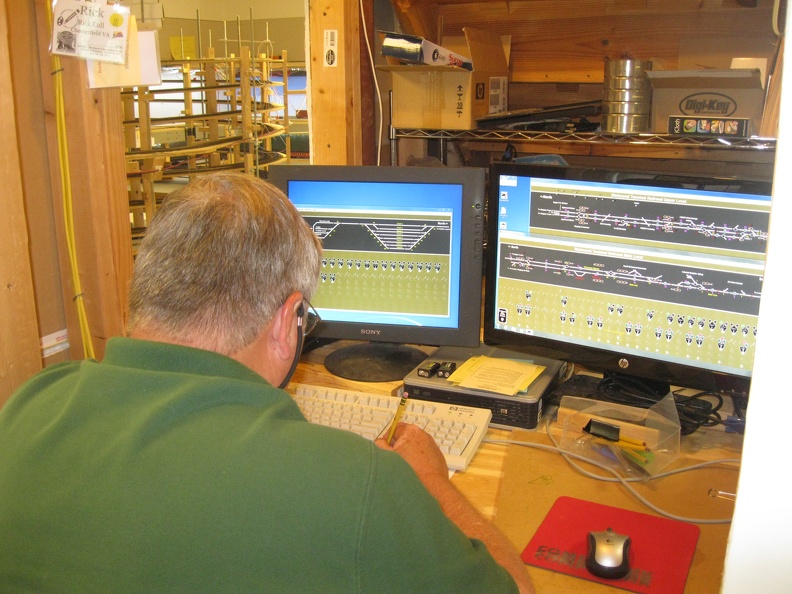 |
| Here we find our fearless dispatcher, Dick M, making a note as the session progresses. |
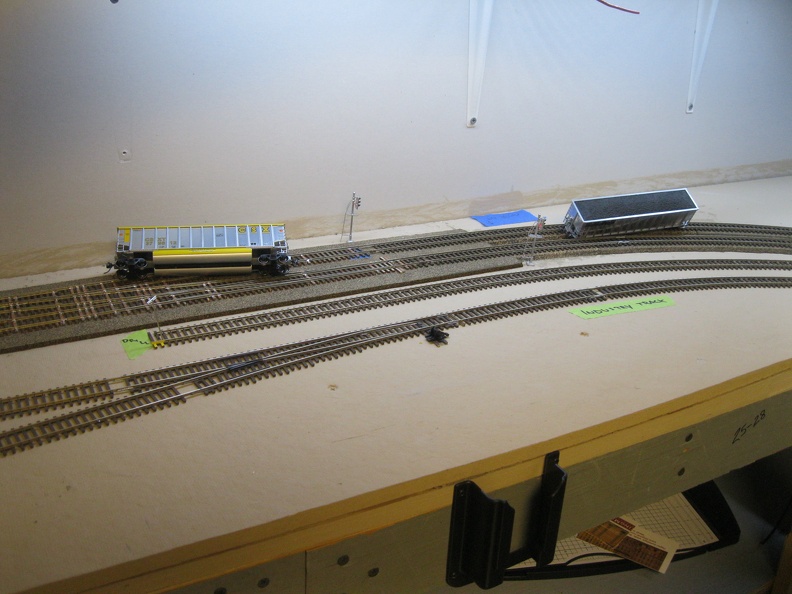 |
| Ah, the joys of experienced crews! |
Tuesday, May 12, 2015
Update
I will have some reviews about RockyOp coming fairly soon, as well as a post or three about where the layout is going.
Sorry about the lack of content here lately.
Sorry about the lack of content here lately.
Wednesday, April 22, 2015
Half a Sky
Started getting back and working on the layout after a pretty long layoff.
The next step is getting the backdrops painted a nice blue. My plan is to use two different shades of blue to hopefully give me the right slope of color across the sky.
So, here's the top, darker, color in a couple of shots.
The next step is getting the backdrops painted a nice blue. My plan is to use two different shades of blue to hopefully give me the right slope of color across the sky.
So, here's the top, darker, color in a couple of shots.
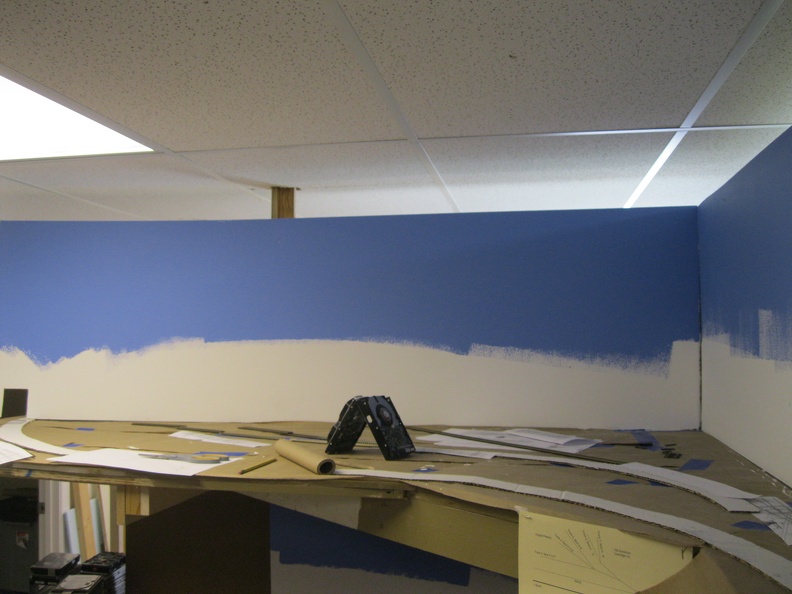 |
| Bear Island paper mill area in foreground |
Friday, March 13, 2015
Book Review - RF&P Passenger Service 1935 to 1975, William Griffin, Jr, TLC Publishing 2000
Richmond Fredericksburg and Potomac Railroad Passenger Service 1935 to 1975
Author William E. Griffin Jr
TLC Publishing 2000, Hardbound, 106 pages
TLC Publishing 2000, Hardbound, 106 pages
As promised on the full website, I will be reviewing books from my library that I would think is interesting to my readership or that have direct bearing on my modeling.
This book falls into the interesting rather that direct modeling, but I find the pre-Amtrak era of passenger service fascinating.
The book's cover is a wonderful shot of one of the RF&P's E8 A-B unit pairs southbound just north of Richmond, headed to Broad Street Station.
The book starts with a chapter on through service, as it
was the most common type on the line. Not a shocking fact, as the railroad was a major North-South bridge line. A 1956 passenger timetable is
reproduced, showing 16 (!) daily trains. One additional Monday through Saturday train is listed, so you would expect to see 18 trains a day had you been trackside. Now, I have a copy in my collection of the first Amtrak timetable for the RF&P's line, which has only 6 trains a day showing - 3 north and 3 southbound. A RF&P timetable from 1968 has 14 trains listed. A note is made on how SAL trains were numbered over the line, as the RF&P handled trains from both the ACL and Seaboard northbound. The book also has a short discussion here about the equipment that was contributed to the car pools that were
maintained to handle the service. Both diesel and steam powered trains are discussed with many
pictures sprinkled throughout the text. Related foreign road power is
also discussed and pictures are included. My only complaint here is that most of these are B&W shots, but I imagine the sources the author worked from are B&W so this is a shortcoming of the source material instead of the book itself. However, there is a dedicated color photo chapter near the end; I imagine that with color film only becoming available commercially in the mid 1930's, that the expense for somebody shooting color trackside would be significant.
Chapter 2 is local and connection service. Locals were not as numerous, as talked in the text due to the early building of highways in the area that the line ran, especially between Ashland and Richmond. An interesting point is that there were 15 flag stops between Ashland and Richmond in the 1920s, which would be totally unheard of today. Today, you could buy a ticket on Amtrak from Ashland (though not at the station, as it isn't manned by Amtrak nor is there an automated kiosk. Your option is to either buy a ticket at a different station or purchase via their website.) to either Main Street or Staples Mill, but folks would probably look at you askance, as the closeness of Interstate 95 and US1 and the ubiquity of the car seemingly precludes this. Interestingly, the railroad spun off a bus company to handle this business in the 1920's as well. A gas electric was purchased in 1928 to reduce the operating cost of local service on the north end. The book states that the last local trains to run were #10 and #29 in January 1957. On a slightly happier note, connecting service with the C&O and N&W are discussed with many pictures, as well as a timetable. The N&W service to Broad Street Station is what provided us with great pictures of the K2 class (a 4-8-2 with similar streamlining to the famous J class) leaving the station, and was also the inspiration for some wonderful railroad art as well.
We move on to the special trains of the railroad, dedicating a chapter to the subject, which details their success over the years. What is interesting about this situation is that special trains ran up until the advent of Amtrak, while local service didn't make it out of the 1950s. A trivia bit here is that for some years, the railroad was the largest ticket holder of the Washington Redskins, controlling a block of 600 seats. One wonders with the spring training site for the team now being in Richmond, what sort of deals would the RF&P have offered from the Washington area south, had the railroad still be independent of Jacksonville.
A chapter on Amtrak follows and the short lived, independent Auto-Train corporation is here is well. We have many color shots here, as Amtrak is a child of the 1970s and color film was cheap. (Well, certainly cheaper than in the 30s or 40s!)
Chapter 5 is all about the passenger stations, with the edifice of Broad Street given particular attention, with many aerial photographs. From there, the chapter covers stations spot by stop heading to the northern most station at Alexandria. Washington Union Station is mentioned, but isn't properly a RF&P only facility, as it was jointly shared with many railroads. Floor plans and exterior shots are sprinkled throughout, making this very helpful to the prototype modeler.
Chapter 6 covers passenger rolling stock with gratuitous pictures. Cars lists from 1960 and 1970 are included; each is a complete roster with type of car, the number and even name, if the car was named. The RF&P both used its own cars as well as those from other railroad depending on the train service, as well as contributing cars to the service pools. Some of these cars were built from similar plan used by other railroads that are frequently targets of the model manufacturers, giving the modeler easier starting points if they want to build a collection of rolling stock.
Chapter 7 is color photographs which closes out the book nicely. The first 3 pictures are all broad street station pieces, which I enjoy.
Chapter 2 is local and connection service. Locals were not as numerous, as talked in the text due to the early building of highways in the area that the line ran, especially between Ashland and Richmond. An interesting point is that there were 15 flag stops between Ashland and Richmond in the 1920s, which would be totally unheard of today. Today, you could buy a ticket on Amtrak from Ashland (though not at the station, as it isn't manned by Amtrak nor is there an automated kiosk. Your option is to either buy a ticket at a different station or purchase via their website.) to either Main Street or Staples Mill, but folks would probably look at you askance, as the closeness of Interstate 95 and US1 and the ubiquity of the car seemingly precludes this. Interestingly, the railroad spun off a bus company to handle this business in the 1920's as well. A gas electric was purchased in 1928 to reduce the operating cost of local service on the north end. The book states that the last local trains to run were #10 and #29 in January 1957. On a slightly happier note, connecting service with the C&O and N&W are discussed with many pictures, as well as a timetable. The N&W service to Broad Street Station is what provided us with great pictures of the K2 class (a 4-8-2 with similar streamlining to the famous J class) leaving the station, and was also the inspiration for some wonderful railroad art as well.
We move on to the special trains of the railroad, dedicating a chapter to the subject, which details their success over the years. What is interesting about this situation is that special trains ran up until the advent of Amtrak, while local service didn't make it out of the 1950s. A trivia bit here is that for some years, the railroad was the largest ticket holder of the Washington Redskins, controlling a block of 600 seats. One wonders with the spring training site for the team now being in Richmond, what sort of deals would the RF&P have offered from the Washington area south, had the railroad still be independent of Jacksonville.
A chapter on Amtrak follows and the short lived, independent Auto-Train corporation is here is well. We have many color shots here, as Amtrak is a child of the 1970s and color film was cheap. (Well, certainly cheaper than in the 30s or 40s!)
Chapter 5 is all about the passenger stations, with the edifice of Broad Street given particular attention, with many aerial photographs. From there, the chapter covers stations spot by stop heading to the northern most station at Alexandria. Washington Union Station is mentioned, but isn't properly a RF&P only facility, as it was jointly shared with many railroads. Floor plans and exterior shots are sprinkled throughout, making this very helpful to the prototype modeler.
Chapter 6 covers passenger rolling stock with gratuitous pictures. Cars lists from 1960 and 1970 are included; each is a complete roster with type of car, the number and even name, if the car was named. The RF&P both used its own cars as well as those from other railroad depending on the train service, as well as contributing cars to the service pools. Some of these cars were built from similar plan used by other railroads that are frequently targets of the model manufacturers, giving the modeler easier starting points if they want to build a collection of rolling stock.
Chapter 7 is color photographs which closes out the book nicely. The first 3 pictures are all broad street station pieces, which I enjoy.
A bibliography brings up the markers.
If you are interested in the RF&P, or just enjoying learning about pre-Amtrak service, I recommend the book to you.
Friday, February 20, 2015
Railfanning as Prototype Research
As I have discussed on this blog, as well as the railroad website, I have been collecting as much information as I can about the area, railroads, industries and operations of who/what/where I am attempting to model.
All this research certainly can take away from modeling time, I will admit, but this isn't 100% the case. Sometimes I am collecting information during a time that I can't do any direct modeling, such as during my lunch hour, or when I'm traveling. It is true that if I take a Saturday afternoon to stand trackside and shoot pictures, I am not in the basement laying track, or detailing locomotives, or fixing cars on the RIP track from last session.
I've also been able to snag additional materials by keeping my eyes open. A recent win was finding a RF&P book from Morning Sun on sale from a dealer; this book is out of print so a bit harder to find, especially at a discount. I also was able to score a new (to me) ACL book that was saved from an archive at the C&O Historical Society. (I will be putting a review up on the site about these books and mentioning it here too.)
While I have been researching to make my modeling better, one of the big pieces is being able to document what I see on a daily basis around town, such as when signals get replaced.
At first glance, this point may or may not be obvious to everybody, but I believe that once you consider it at length, you will realize this is simple, yet powerful.
Prototype modeling is all about replicating the normal, day to day business of railroading. Some may even say that you are copying the mundane, and that may or not be a strong word depending on one's point of view, but no matter what, first hand knowledge of the subject is vital to prototype modeling efforts.
How is it vital? It makes it easier!
Collecting this information is done on a couple of fronts - noticing what is taking place, networking with other railfans, railroad employees and modelers to get the latest gouge, and documenting what is going on.
I think the first two are fairly basic so I will leave them as they sit and we will go a bit deeper into the 3rd piece - the actual documentation.
As the cliche goes - a picture is worth a thousand words. Memories can fade or change as time goes along, but having photos in hand is almost as good as being there again. Capturing good pictures also allows you to fill out other documents, such as consist information, locomotives used, routing information, and car/container reporting marks.
Up until this point, I had just been using a simple point and shoot type of camera. These cameras are good at taking snapshots, but they do have limitations.
With a standard pocket camera, your lens is only so good and then the sensor itself, is only so physically large (don't get too hung up about the number of megapixels), so this makes getting photos with lots of useable details at 100% or larger size, a bit challenging when you are further away than say 20 or 25 feet. If you are hundreds of feet away and can't get any closer, your little pocket wonder will really show its limits. Don't forget that these jewels mostly autofocus and have no ability to do anything manual, so trying to shoot a train moving past you quickly can be hard as the camera tries to work on a continually changing view. Also, the list of settings you can change that directly affect the picture (ISO, Shutter Speed, f/stop, plus white balance) is somewhat limited, as these cameras are built to get good photos in common situations, but this means that covering edge cases is difficult.
So, now that we've talked about what I'm trying to do, you can see that getting good results a bit challenging. A fact of railfanning in the post September 11 era is to ensure you stay off railroad property and not become threatening or suspicious. (And I'll save the snark about who actually won this war for a different forum).
So let's plan to stay on the sidewalk or at least off of railroad property. Our requirements are now a camera with interchangeable lenses, as we can tailor our choice to how far away we are. We can get a lens made for wide shots if we are close, such as on a passenger platform, or a zoom if we up on a road overpass with good sidewalks.
There are boatloads of options from a camera standpoint (manufacturer, mirror or mirrorless, lens mount type, storage type, saved picture format, etc) and discussing them is outside the scope of this blog post, but if you start out, I recommend a base level DSLR (Digital Single Lens Reflex) with its included lens. If you know that a good spot to stand if a bit farther away, feel free to add a zoom lens that has a max zoom of 200 or 300 mm. Often you will get money off an additional lens if you buy with the camera.
Then, charge your batteries (you did buy a second one, right?) and go out and shoot pictures.
Don't expect awesome results as you get going; it takes time to learn what to do (and what not to do).
What follows are some sample photos I've captured since starting this last December.
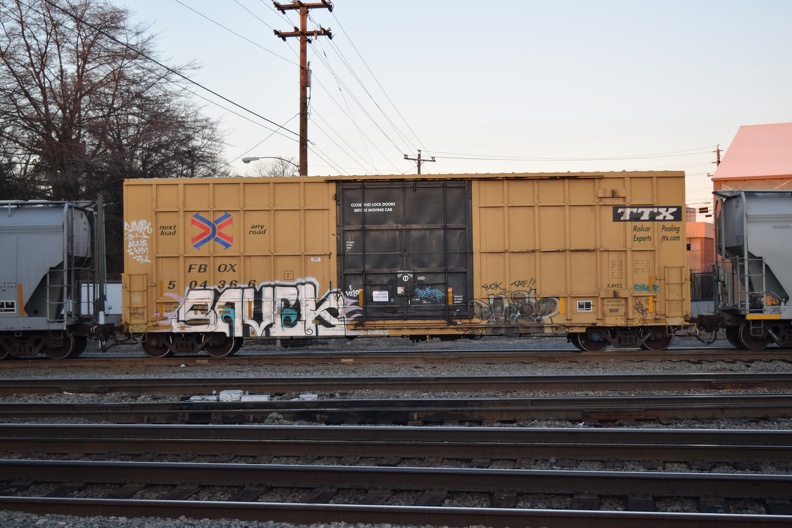
All this research certainly can take away from modeling time, I will admit, but this isn't 100% the case. Sometimes I am collecting information during a time that I can't do any direct modeling, such as during my lunch hour, or when I'm traveling. It is true that if I take a Saturday afternoon to stand trackside and shoot pictures, I am not in the basement laying track, or detailing locomotives, or fixing cars on the RIP track from last session.
I've also been able to snag additional materials by keeping my eyes open. A recent win was finding a RF&P book from Morning Sun on sale from a dealer; this book is out of print so a bit harder to find, especially at a discount. I also was able to score a new (to me) ACL book that was saved from an archive at the C&O Historical Society. (I will be putting a review up on the site about these books and mentioning it here too.)
While I have been researching to make my modeling better, one of the big pieces is being able to document what I see on a daily basis around town, such as when signals get replaced.
At first glance, this point may or may not be obvious to everybody, but I believe that once you consider it at length, you will realize this is simple, yet powerful.
Prototype modeling is all about replicating the normal, day to day business of railroading. Some may even say that you are copying the mundane, and that may or not be a strong word depending on one's point of view, but no matter what, first hand knowledge of the subject is vital to prototype modeling efforts.
How is it vital? It makes it easier!
Collecting this information is done on a couple of fronts - noticing what is taking place, networking with other railfans, railroad employees and modelers to get the latest gouge, and documenting what is going on.
I think the first two are fairly basic so I will leave them as they sit and we will go a bit deeper into the 3rd piece - the actual documentation.
As the cliche goes - a picture is worth a thousand words. Memories can fade or change as time goes along, but having photos in hand is almost as good as being there again. Capturing good pictures also allows you to fill out other documents, such as consist information, locomotives used, routing information, and car/container reporting marks.
Up until this point, I had just been using a simple point and shoot type of camera. These cameras are good at taking snapshots, but they do have limitations.
With a standard pocket camera, your lens is only so good and then the sensor itself, is only so physically large (don't get too hung up about the number of megapixels), so this makes getting photos with lots of useable details at 100% or larger size, a bit challenging when you are further away than say 20 or 25 feet. If you are hundreds of feet away and can't get any closer, your little pocket wonder will really show its limits. Don't forget that these jewels mostly autofocus and have no ability to do anything manual, so trying to shoot a train moving past you quickly can be hard as the camera tries to work on a continually changing view. Also, the list of settings you can change that directly affect the picture (ISO, Shutter Speed, f/stop, plus white balance) is somewhat limited, as these cameras are built to get good photos in common situations, but this means that covering edge cases is difficult.
So, now that we've talked about what I'm trying to do, you can see that getting good results a bit challenging. A fact of railfanning in the post September 11 era is to ensure you stay off railroad property and not become threatening or suspicious. (And I'll save the snark about who actually won this war for a different forum).
So let's plan to stay on the sidewalk or at least off of railroad property. Our requirements are now a camera with interchangeable lenses, as we can tailor our choice to how far away we are. We can get a lens made for wide shots if we are close, such as on a passenger platform, or a zoom if we up on a road overpass with good sidewalks.
There are boatloads of options from a camera standpoint (manufacturer, mirror or mirrorless, lens mount type, storage type, saved picture format, etc) and discussing them is outside the scope of this blog post, but if you start out, I recommend a base level DSLR (Digital Single Lens Reflex) with its included lens. If you know that a good spot to stand if a bit farther away, feel free to add a zoom lens that has a max zoom of 200 or 300 mm. Often you will get money off an additional lens if you buy with the camera.
Then, charge your batteries (you did buy a second one, right?) and go out and shoot pictures.
Don't expect awesome results as you get going; it takes time to learn what to do (and what not to do).
What follows are some sample photos I've captured since starting this last December.

Monday, February 16, 2015
Richmond Amtrak Schedule
I've been doing a fair amount of rail fanning recently and to that end, I've worked out an concise schedule of when certain trains should be seen here in Richmond. I was able to winnow this down from the timetables that Amtrak provides and their schedule tool on their website.
Times are show as listed per station, then the train name and number (handy to check status via Amtrak's mobile app on your phone as you sit trackside).
RVR = Staples Mill Station, Richmond
PTB = Petersburg Station
NPN = Newport News
Without further ado:
Weekday Schedule
Southbound
Depart RVR Arrive PTB
Wed 12:02 pm Wed 12:32 pm Palmetto 89
Wed 1:10 pm Wed 1:43 pm Carolinian 79
Wed 5:19 pm Wed 5:57 pm Silver Star 91
Wed 6:26 pm Wed 7:00 pm NE Regional 125
Wed 9:50 pm Wed 10:24 pm Silver Meteor 97
Depart RVR Arrive NPN
Wed 9:45 am Wed 11:50 am Northeast Regional 67
Wed 4:45 pm Wed 6:50 pm Northeast Regional 95
Autotrain 4pm Depart
Northbound
Depart PTB Arrive RVR
Wed 3:41 am Wed 4:25 am Silver Meteor 98
Wed 6:27 am Wed 7:03 am Neast Regional 174
Wed 11:52 am Wed 12:21 pm Silver Star 92
Wed 1:20 pm Wed 2:05 pm Carolinian 80
Wed 4:31 pm Wed 5:15 pm Palmetto 90
Depart NPN Arrive RVR
Wed 9:15 am Wed 10:59 am Northeast Regional 94
Wed 5:20 pm Wed 6:55 pm Northeast Regional 66
Weekend Schedule
Southbound
Depart RVR Arrive PTB
Sun 12:02 pm Sun 12:32 pm Palmetto 89
Sun 1:10 pm Sun 1:43 pm Carolinian 79
Sun 5:19 pm Sun 5:57 pm Silver Star 91
Sun 9:24 pm Sun 9:58 pm NE Regional 71
Sun 9:50 pm Sun 10:24 pm Silver Meteor 97
Depart RVR Arrive NPN
Sun 10:11 am Sun 12:05 pm Northeast Regional 65
Sun 7:10 pm Sun 9:10 pm Northeast Regional 99
Northbound
Depart PTB Arrive RVR
Sun 3:41 am Sun 4:25 am Silver Meteor 98
Sun 7:42 am Sun 8:18 am NE Regional 88
Sun 11:52 am Sun 12:21 pm Silver Star 92
Sun 1:20 pm Sun 2:05 pm Carolinian 80
Sun 4:31 pm Sun 5:15 pm Palmetto 90
Depart NPN Arrive RVR
Sun 8:15 am Sun 9:50 am Northeast Regional 194
Sun 5:20 pm Sun 6:55 pm Northeast Regional 66
Times are show as listed per station, then the train name and number (handy to check status via Amtrak's mobile app on your phone as you sit trackside).
RVR = Staples Mill Station, Richmond
PTB = Petersburg Station
NPN = Newport News
Without further ado:
Weekday Schedule
Southbound
Depart RVR Arrive PTB
Wed 12:02 pm Wed 12:32 pm Palmetto 89
Wed 1:10 pm Wed 1:43 pm Carolinian 79
Wed 5:19 pm Wed 5:57 pm Silver Star 91
Wed 6:26 pm Wed 7:00 pm NE Regional 125
Wed 9:50 pm Wed 10:24 pm Silver Meteor 97
Depart RVR Arrive NPN
Wed 9:45 am Wed 11:50 am Northeast Regional 67
Wed 4:45 pm Wed 6:50 pm Northeast Regional 95
Autotrain 4pm Depart
Northbound
Depart PTB Arrive RVR
Wed 3:41 am Wed 4:25 am Silver Meteor 98
Wed 6:27 am Wed 7:03 am Neast Regional 174
Wed 11:52 am Wed 12:21 pm Silver Star 92
Wed 1:20 pm Wed 2:05 pm Carolinian 80
Wed 4:31 pm Wed 5:15 pm Palmetto 90
Depart NPN Arrive RVR
Wed 9:15 am Wed 10:59 am Northeast Regional 94
Wed 5:20 pm Wed 6:55 pm Northeast Regional 66
Weekend Schedule
Southbound
Depart RVR Arrive PTB
Sun 12:02 pm Sun 12:32 pm Palmetto 89
Sun 1:10 pm Sun 1:43 pm Carolinian 79
Sun 5:19 pm Sun 5:57 pm Silver Star 91
Sun 9:24 pm Sun 9:58 pm NE Regional 71
Sun 9:50 pm Sun 10:24 pm Silver Meteor 97
Depart RVR Arrive NPN
Sun 10:11 am Sun 12:05 pm Northeast Regional 65
Sun 7:10 pm Sun 9:10 pm Northeast Regional 99
Northbound
Depart PTB Arrive RVR
Sun 3:41 am Sun 4:25 am Silver Meteor 98
Sun 7:42 am Sun 8:18 am NE Regional 88
Sun 11:52 am Sun 12:21 pm Silver Star 92
Sun 1:20 pm Sun 2:05 pm Carolinian 80
Sun 4:31 pm Sun 5:15 pm Palmetto 90
Depart NPN Arrive RVR
Sun 8:15 am Sun 9:50 am Northeast Regional 194
Sun 5:20 pm Sun 6:55 pm Northeast Regional 66
Friday, February 13, 2015
Task List
As I said in the post last month, not much has been going on, on the railroad.
I've been suffering from a bit of low motivation with the railroad, as well as being pulled in lots of directions with the rest of life.
I had been putting off starting the build of the paper mill area until I painted the backdrops in that area, but that hadn't happened due to lack of paint which was due to lack of railroad funds and cold in the basement.
Last Sunday was very warm (almost 70), so I when to Home Depot, bought paint, and got ready to paint sometime in the next few weeks. If need be, I can run the heater in the basement for a day or three to get the paint dry.
Once the paint is complete here, I'll start laying out track and finding what works in this area. Next step is building track. My plan is to build just about all the paper mill track work from code 70 rail, with a mix of Micro-Engineering flex, handlaid and Fast Tracks jig built turnouts.
Signal wise, I think I only have the area around the turnout to this paper mill branch to be completed, so we are coming to the end of that process.
I do need to mud, tape and sand the drywall backdrop on the upper level along the wall, but that will probably need to wait for summer and warmer temps in the basement, as running the heater to the level of getting mud to dry would probably double the electric bill.
I might be try a work session or two on a Sunday or Saturday, but schedules haven't been too kind here lately.
I've been suffering from a bit of low motivation with the railroad, as well as being pulled in lots of directions with the rest of life.
I had been putting off starting the build of the paper mill area until I painted the backdrops in that area, but that hadn't happened due to lack of paint which was due to lack of railroad funds and cold in the basement.
Last Sunday was very warm (almost 70), so I when to Home Depot, bought paint, and got ready to paint sometime in the next few weeks. If need be, I can run the heater in the basement for a day or three to get the paint dry.
Once the paint is complete here, I'll start laying out track and finding what works in this area. Next step is building track. My plan is to build just about all the paper mill track work from code 70 rail, with a mix of Micro-Engineering flex, handlaid and Fast Tracks jig built turnouts.
Signal wise, I think I only have the area around the turnout to this paper mill branch to be completed, so we are coming to the end of that process.
I do need to mud, tape and sand the drywall backdrop on the upper level along the wall, but that will probably need to wait for summer and warmer temps in the basement, as running the heater to the level of getting mud to dry would probably double the electric bill.
I might be try a work session or two on a Sunday or Saturday, but schedules haven't been too kind here lately.
Tuesday, January 13, 2015
Quick Update
Not much happened since I've blogged last; an additional op session was run and a handful of things have been done, but besides that, nothing much is going on with the railroad right now.
Subscribe to:
Posts (Atom)
